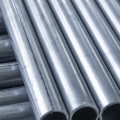The pipe inside the house is called a gas supply line or construction line. The branches go to the individual devices. The bypass line terminates in a downcomer line, which is a vertical pipe that descends to the apparatus from an aerial bypass line. The most common materials used to make gas pipes are steel, black iron, polyvinyl chloride (PVC), high-density polyethylene (HDPE) and copper.
Some utilities prohibit some of these materials, so be sure to check with your local utility company to determine what is allowed in your area before installing any. If you hire a professional to do the work, they will know the local requirements. Black Pipe Black steel pipe is different from galvanized pipe because it is not coated. The dark color comes from iron oxide that forms on its surface during manufacturing.
The main purpose of black steel pipe is to bring natural gas to homes and businesses. The pipe is manufactured seamless, making it a stronger and safer pipe for transporting gas. Black steel pipe is also used for fire sprinkler systems because it is more fire resistant than galvanized pipe. You may be familiar with the “galvanized pipe for gas”.
The black iron pipe is simply the same, but without the zinc coating. The zinc coating on the galvanized pipe for gas is intended to prevent the pipe from being corroded by contact with moisture. While it does its job quite well, over time, it still corrodes. Black tubes are also called steel tubes and are used to transport water and gas from their sources to end users.
It is the pipe that businesses and households use to transport their supply of natural gas or propane. Newer homes built in the last 10 to 15 years often have a CSST gas system. CSST stands for Stainless Steel Corrugated Pipe. It is a flexible tube, lightweight and easy to install.
Although it is more expensive than black iron in terms of material costs, the ease of installation usually makes up for it in labor costs. This is why it has become a favorite of many home builders. PVC gas pipes work well for underground outdoor gas lines because they are durable and resistant to corrosion. The total cost of your gas pipeline will depend on whether or not you have existing gas lines or if you need to install completely new lines.
When the gas line starts to leak underground, it can lead to a dead grass stain above the leak, a strong sulfur smell in the area above the leak, and a high gas bill. You may need to talk to your natural gas supplier and local construction official about the specifications of natural gas supplied in your area. After extracting natural gas, it travels along a road-like piping system to end up in distribution systems that carry the gas to your home. Gas pipes are a piping system in your home that is used to transport natural gas from the supply directly to the heating system.
But natural gas is much cleaner than it was 40 years ago, and almost all fuel gas goes through a sulfur recovery unit before entering the distribution system today. The gas goes from the distribution line, also known as a main line, to a house or other building on a service line, which the natural gas company is responsible for maintaining. Assuming the same pressure and pressure drop for copper tubing, natural gas will produce 40% less BTU than your existing propane distribution system, if you were to consult the gas size tables in the IFGC. As you may or may not be aware, the installation of plumbing pipes and fittings is governed by a set of rules, known as the Universal Plumbing Code (or “UPC)”.
In my experience, both types of piping work well, and the IRC and the National Combustible Gas Code allow both, along with stainless steel corrugated tubing (CSST) and copper tubing (with some limitations) to be used for natural gas distribution pipelines. Any anxiety you may feel about your gas system can be alleviated if you learn a little more about what to expect from gas system maintenance. .




